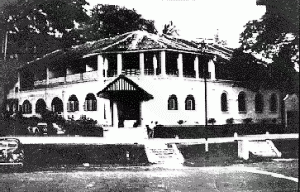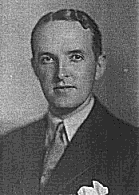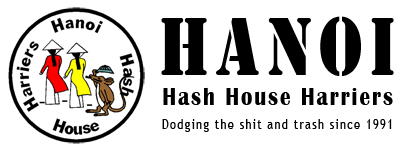Hanoi
If you like a regular social gathering with a couple of drinks and a
bit of sweat, the Hash might be something for you. The idea of hashing
was born around 1938 in Kuala Lumpur, Malaya, as a club for drinkers with a running problem.
They called themselves the Hash House Harriers (HHH), named after the
building were they started from. You can find more details about the
origins below.
Nowadays an estimated 2030 chapters, spanning all 7 continents, in
1330 cities and 185 countries uphold this tradition on a regular base.
The Hash is a very social and international, recreational cross-country running for fun activity. Every Hash chapter has its own interpretation of this idea, but generally, the pack (the runners) try to follow a trail, laid by one or two club members (the Hares or Does).
By putting false trails, the Hares make sure that quick runners arrive
more or less at the same time at the finish as the
crawlers/walkers/joggers. There are no winners and upon completion,
everybody is rewarded with a couple of drinks in the ‘circle’ where the
emphasis is on fun and spontaneity.
There is no membership, when you show up for a run, you’re in. The
trail consists of dots of flour, leading through paddies, an occasional
hill, hidden alleys, smelly neighborhoods and picturesque quarters.
It’s fun!
History of the Hash House Harriers as Recorded by the Mother Hash
The Hash House

The Original Hash House (Kuala Lumpur) Circa 1938
The ‘Hash House’ was the mildly
derogative nickname given (for its unimaginative, monotonous food) to
the Selangor Club Chambers, by the British Civil Servants and
businessman who lived and dined there. Originally, the ground floor
housed the main Selangor Club dining room, and between the two World
Wars it became a social center of the times, used regularly for lunch
time meals by the members who worked in the immediate vicinity.
Situated close to and behind the present
Selangor Club, it’s function changed after independence and it became a
key office for the local Water Board, as it was the place where all
Kuala Lumpur (K.L.) residents came to pay their water bills. Sadly, it
gave way to the relentless march of time around 1964, being bulldozed to
the ground under the north-bound lane Jalan Kuching. The buildings
housing the original stables and servants quarters are still in
existence.
Ancient Harriers
The idea of Harriers chasing paper was
not new to Malaya in 1938, as there had been such clubs before in Kuala
Lumpur and Johore Bahru, and there were clubs in existence in Malacca
and Ipoh (the Kinta Harriers) at the time. “Horse” Thomson (one of the
KLH3 founding fathers) recalled being invited on a run, shortly after
his arrival in Johore Bahru in 1932, which chased a paper trail and
followed basic Hash rules every week but was so magically organized that
it had no name. The club flourished in the early 1930’s but is believed
to have died out around 1935.
The other branch of our ancestry comes
from Malacca, where A. S. (‘G’) Gispert was posted in 1937 and joined a
club called the Springgit Harriers, who also operated weekly under Hash
rules and are believed to have been formed in 1935. Some months later,
‘Torch’ Bennett visited him and came as a guest on a few runs.
Hash House Harriers
By 1938, Thomson, Lee, and Gispert had
all moved to K.L. and founded their own club, following the rules they
had learnt elsewhere. The principal original members were:

- A. S. (‘G’) Gispert
- Cecil Lee
- ‘Horse’ Thomson
- Torch’ Bennett
- Eric Galvin
- H.M. Doig
Soon joined by others, including:
- Frank Woodward
- Philip Wickens
- Lew Davidson
- John Wyatt-Smith
- M. C. Hay
It is not clear that the club actually
had a name at the very beginning, but Gispert is credited with proposing
the ‘Hash House Harriers’ when the Registrar of Societies required the
gathering to be legally registered.
‘Torch’ Bennett technically missed being
a founder member, because he was then on leave, bout on his return he
introduced the first necessary organization – a bank account, a balance
sheet and some system. More importantly, he seems, with Philip Wickens
who joined later in 1939, to have helped to keep things going
immediately after the war.
Sadly, Gispert had only a short time
with his extraordinary creation, being killed in the fighting on
Singapore Island on February 11th, 1942, whilst serving with the
Argylls. But with the exception of Philip Wickens who died in 1981, and
Lew Davidson who died very recently, the rest of the hardy band of
hashers hare still with us and the KL hash House Harriers keeps in touch
with them all. [Editor’s note: Torch died soon after this was prepared in 1992]
The founding members were all British,
although Gispert was actually Spanish in origin, his parents having
migrated to London some time before he was born. Extraordinarily both he
and Bennett were accountants, as were Paul Barnard and Jack Bridewell
who made a significant contribution to our activities of later years.
Some Hash psychiatrist should investigate where this work leads to
extreme forms of escapism.
The HHH duly celebrated it 100th run on
15 August 1941, but only 17 runs later was forced into temporary
hibernation by the arrival of the Japanese.
Postwar Rebirth
Post World War II, it was nearly 12
months before the survivors reassembled. ‘Torch’ Bennett put in a claim
for the lost hash mugs, a tin bath and two old bags, on the fund set up
with the proceeds from confiscated Japanese property and run No. 1 was a
trot around the race-course in August, 1946. Subsequent to the 1,000th
post war run the celebrations surround it were considered to be such a
success that the 117 official pre-war runs were added to the total as we
could celebrate the 2,000th run as soon as possible.
With the advent of the Emergency in
1948, the Hash was automatically in bad official odor, as their
activities were generally illegal in terms of the curfew imposed on most
of the areas surround Kuala Lumpur and in the years 1948-51, they
maintained a precarious existence at best. The turn round came with the
famous bandit incident at Cheras.
This has been widely misreported, but
what actually happened was that below where the Lady Templer Hospital is
now, in an area that was then rubber and belukar, the Hares on a
darkening and rainy evening came across some men wrapped in ground
sheets sleeping on the ground. The following pack found the bandits on
their feet but someone, in the general confusion nobody got hurt. One
member ran to Cheras Police Station and raised the alarm; the army laid
ambushes on tracks leading out of the area and first thing the following
morning bagged three bandits trying to break out. One of them was found
to have a substantial price on his head and the bounty was shared among
the non-government employees on the run (government servants were not
allowed to participate in such rewards).
Other colorful incidents related by
Cecil Lee, include how ‘Torch’ Bennett once nearly drowned in quicksand,
and how on one memorable occasion the erstwhile unathletic ‘G’ was
actually leading the pack: sadly his moment of glory was short lived as
the paper trail turned to be false. Swimming would seem to be an
unofficial prerequisite to all Hashmen too, for Cecil remembers having
had to swim across a mining pool in order to get home after being lost
on one occasion, and on another it is reported that several Hashmen ran
in to a stream where bathed some unsuspecting Malay maidens. The girls
screamed; their menfolk came hurtling to the rescue with the unsheathed
parangs flashing, and the errant Hashmen broke land speed records in the
eagerness to clear the scene.
The Hash Spreads Out
The second Hash Chapter was founded in Singapore in 1962,
[Editor’s note: The Royal Italian Bordighera Hash was begun in the late
’40s but died by the late ’50s. It was later resurected by members of
the Milan H3] followed by Kuching in 1963, Brunei, Kota
Kinabalu and Ipoh in 1964, Penang in 1965, and Perth was the first
outside Malaysia and Singapore in 1967. Even by the time of K.L. 1,500th
run in 1974 the total was only 35, so the subsequent explosion has been
spectacular indeed. The 1992 international list will total around 1,100
clubs in over 135 countries and all continents (including Antarctica)
where the hash format is often adapted to environments very different
from the near rows of Malaysian rubber trees amongst which it was
conceived. Kabul HHH understandably foundered, but what can it be like
to hash in Sinai, Peking, Addis Ababa or the Falkland Islands? [Editor’s
note: The aforementioned second hash dating back to 1962 was founded in
Singapore by Ian Cumming who is still actively hashing with the New
York H3. He is also a primary contributor to every hash songbook].
Interhash
The first attempt at an Interhash
get-together was the K.L. 1,000th post-war run in 1966, and the
spectacular 1500th run in 1973 when attendance was something over 300.
Interhash 1978 in Hong Kong broke new ground with an attendance around
800; Interhashes 1980 and 1982 were credited with 1,200 – 1,300;
Interhash 1984 with rather more Interhash 1986 broke the 2,000 barrier
with 2,143.
Attendance at Bali for Interhash 1988
was reported to bet between 2,600 and 2,700. Interhash 1990 in Manila
was affected by the then current state of emergency in the country, but
nevertheless some 1,600 intrepid Hashers were let loose in Manila and
survived to tell the tale.
Interhash 1992 in Phuket, Thailand does
not seem to be affected by the recent unhappy turmoil in Bangkok and,
judging by reported registrations the numbers are set to pass 3,000. [Editor’s
note: Interhash 1994 in New Zealand drew nearly 4,000, Interhash 1996
in Cyprus drew 6,000 and Interhash 1998 in Kuala Lumpur had over 7,000
participants]
Written
in 1992 by Mike Lyons from the copious research material prepared by
John Duncan. Transcribed in 1994 by Tom “Self-Executing Officer” Moore,
On-Sec, Boston H3, and edited by Chas. “ZiPpY tC” Baumerich, On-Sec,
Pikes Peak H4.
